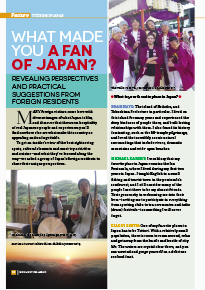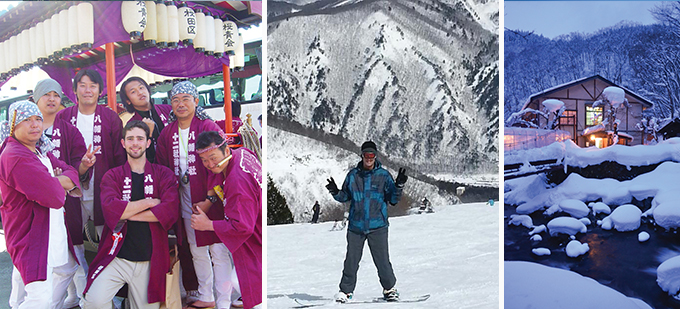Home > Highlighting JAPAN >Highlighting Japan April 2015>Tourism in Japan
Highlighting JAPAN

Tourism in Japan
What made you a fan of Japan?
revealing perspectives and
practical suggestions from foreign residents

Many foreign visitors come here with diverse images of what Japan is like, and discover that the warm hospitality of real Japanese people and experiences you’ll find nowhere else are what make this country so appealing and unforgettable.
To get an insider’s view of the best sightseeing spots, cultural elements and must-try activities and cuisine—and what they’ve learned along the way—we asked a group of Japan’s foreign residents to share their unique perspectives.
What is your favorite place in Japan?
Noam Katz: The island of Shikoku, and Tokushima Prefecture in particular. I lived on this island for many years and experienced the deep kindness of people there, and built lasting relationships with them. I also found its history fascinating, such as the 88-temple pilgrimage, and loved the incredibly scenic natural surroundings that include rivers, dramatic mountains and wide-open beaches.
Michael Kanert: I would say that my favorite place in Japan remains the Izu Peninsula, where I lived during my first two years in Japan. I taught English in a small fishing and tourist town in the peninsula’s southwest, and I still consider many of the people I met there to be my closest friends. Their generosity in welcoming me into their lives—inviting me to participate in everything from sporting clubs to tea ceremonies and taiko (drum) festivals—is something I will never forget.
Ellery Smith: One of my favorite places in Japan has to be Tottori. With a relatively small population, there is room to roam around, relax and get away from the hustle and bustle of city life. The waters are crystal clear there, and you can unwind and gorge yourself on a delicious seafood feast.
What’s your favorite tourist spot?
Michael Kanert: If you’re in Japan in May or June, you have a rare opportunity to see Yuki-no-Otani, or the “Great Snow Field,” in Toyama Prefecture. This is a stretch of mountain road that’s walled in by snow up to twenty meters high on either side. The incredible natural snowfall of Mount Tateyama is carved out every spring to reveal this unparalleled sight.
Danielle Ausems: My favorite tourist spot is Hiraizumi in Iwate Prefecture. The Hiraizumi Cultural Heritage Center is helpful, giving enough explanation in English to help you understand the various ruins, as well as a general history of the area. Many of Hiraizumi’s temples and gardens still stand, making it a picturesque place even without the historical background. If you manage to come in July, you might have the rare pleasure of seeing the Chuson-ji lotus bloom, a flower reintroduced in the modern era from seeds that had been dormant for eight hundred years!
Todd Phillips: If you like snowboarding, I highly recommend visiting Hakuba, a famous ski resort town in Nagano Prefecture in the northern Japan Alps. It boasts several famous ski resorts. After the slopes, relaxing in a real onsen (hot-spring bath) soothes the aches and pains that inevitably accumulate during the day.
What do you like best about Japanese culture?
Selena Hoy: I really like the custom of gift giving. People are generally very thoughtful, and it’s not uncommon to give small gifts to say hello, thank you, or when you go to visit someone. Gift giving is a nice tradition that I try to maintain in my own life.
Michael Kanert: I deeply appreciate the ingrained politeness of Japanese people. This kind of respectful and peaceful attitude illuminates a generosity and calmness that put me at ease wherever I go in Japan.
Nayalan Moodley: The Japanese community spirit. I find people are very honest here, and take extreme pride in their community and personal integrity. As a result, communities are strong and help each other through tough times. If you work hard as well and are an upstanding individual, they will support you as one of their own, regardless of where you come from or what you look like. They will also go out of their way to help visitors and tourists find their way and enjoy their stay.
What Japanese custom surprised you the most?
Noam Katz: The use of white masks to cover the face is something that surprised me quite a bit. That’s because covering one’s face is generally not done in the U.S., and such masks are also usually used only by doctors and nurses, and sometimes cleaning staff. When I first saw people wearing masks on trains and in crowded cities, I wondered if I should be wearing one as well!
Michael Kanert: When I first arrived in Japan, I was quite startled to be greeted with the expression “Irasshaimase” whenever I stepped into a shop. In Canada, you can typically walk into a store unnoticed and browse around without encountering any staff until you ask for help. Now, of course, I find it a welcome greeting—and when I return to Canada, I feel lonely when I walk into a shop and the staff say nothing to me at all.
What souvenir is a must-have from Japan?
Noam Katz: Tenugui—inexpensive, light and compact hand towels made of cotton, and often having intricate designs or colorful patterns. They won’t burden the traveler and their incredible versatility makes them great gifts for others or for your own use, since they can function as towels, wrapping for presents, or simply be hung up for decoration.
Nayalan Moodley: Anything handmade. Japanese artisans are some of the finest in the world, and they perfect their art to levels that I’ve not seen anywhere else, whether it’s a leather bag, designer jacket or a kokeshi doll. If it is handmade in Japan, it’s going to be the best quality you will ever find.
Ghiselle Camacho: A summer yukata (light cotton kimono) for women and girls, and a jinbei (men’s light summer clothes) for men and boys.
What Japanese dish or food do you particularly recommend?
Michael Kanert: While I love so many kinds of Japanese food, I’ve never been able to find anything to match Hiroshima-yaki. This is a regional variant of okonomiyaki, a kind of savory pancake eaten in many areas of Japan. However, in addition to cabbage, batter and meat or seafood, Hiroshima-yaki incorporates soba or udon noodles as well as a fried egg, and can even include cheese or mochi (sticky pounded rice) for a unique dining experience.
Noam Katz: For anyone that likes sushi, I’d recommend trying kaiten-zushi (conveyor belt sushi). These are inexpensive places to eat sushi and quite fun as well. Those who feel less than confident about communicating in Japanese can simply pull their desired food from the conveyor belt. Many kaiten-zushi restaurants have recently begun featuring multilingual menus.
Selena Hoy: I’m vegetarian, so some Japanese food is hard for me to eat. However, I love Japanese macrobiotic food—brown rice, tofu, and colorful and flavorful local seasonal vegetables are a real treat. I love Japanese vegetables like Kyoto carrots, kabocha squash, nanohana (rapeseed), lotus root, bamboo shoots, shungiku (chrysanthemum greens) and many more.
What is one activity tourists should experience before leaving Japan?
Danielle Ausems: For the ultimate in relaxation, a combination of onsen and a ryokan (traditional Japanese inn) is the way to go. My favorite ryokan is up in Aomori Prefecture, a cozy place called Aoni Onsen Ryokan. The main appeal of this place is the gas lanterns that light the rooms, since they use virtually no electricity. There’s no Internet and Wi-Fi signal available, which forces you to take a step back, relax, and reconnect with yourself and nature while you alternate napping with taking long soaks.
Todd Phillips: Visit an izakaya, a Japanese-style bar or pub often housed in older buildings. You can experience a meal unlike anything you’ve had back in your home country—an all-you-can-eat, all-you-can-drink meal at a relatively low cost. Prices range from 3,000 to 5,000 yen, and usually there’s a time limit of two to three hours. Food consists of salads, sashimi (raw fish), grilled meat and seafood. It truly is a wonderful experience!
Is there anything you want to tell tourists coming to Japan?
Ellery Smith: Do as much research into the social norms and cultural faux-pas as you can. I had an embarrassing situation where I stuck my chopsticks into my rice. Apparently, sticking your chopsticks in rice like that is a funeral custom.
Ghiselle Camacho: If traveling through Japan’s rural areas makes you nervous because of language concerns, have a look online. Most towns and cities will have a small English-speaking organization. They are usually volunteer groups. If you contact them directly, they’ll jump at the chance to welcome you, show you their hometown and teach you about Japanese culture.
Danielle Ausems: Please be considerate. Japanese people are very proud of their country’s hospitality and politeness, so chances are low that anyone will try to correct any accidental offensive behavior. On the other hand, if you make a good impression, you might inspire someone you meet to come visit your country as a tourist!
Danielle Ausems, American (3.5 years in Japan)
Ellery Smith, American (3 years in Japan)
Ghiselle Camacho, Canadian (17 years in Japan)
Michael Kanert, Canadian (14 years in Japan)
Nayalan Moodley, South African (7 years in Japan)
Noam Katz, American (10 years in Japan)
Selena Hoy, American (9 years in Japan)
Todd Phillips, New Zealander (21 years in Japan)
© 2009 Cabinet Office, Government of Japan






